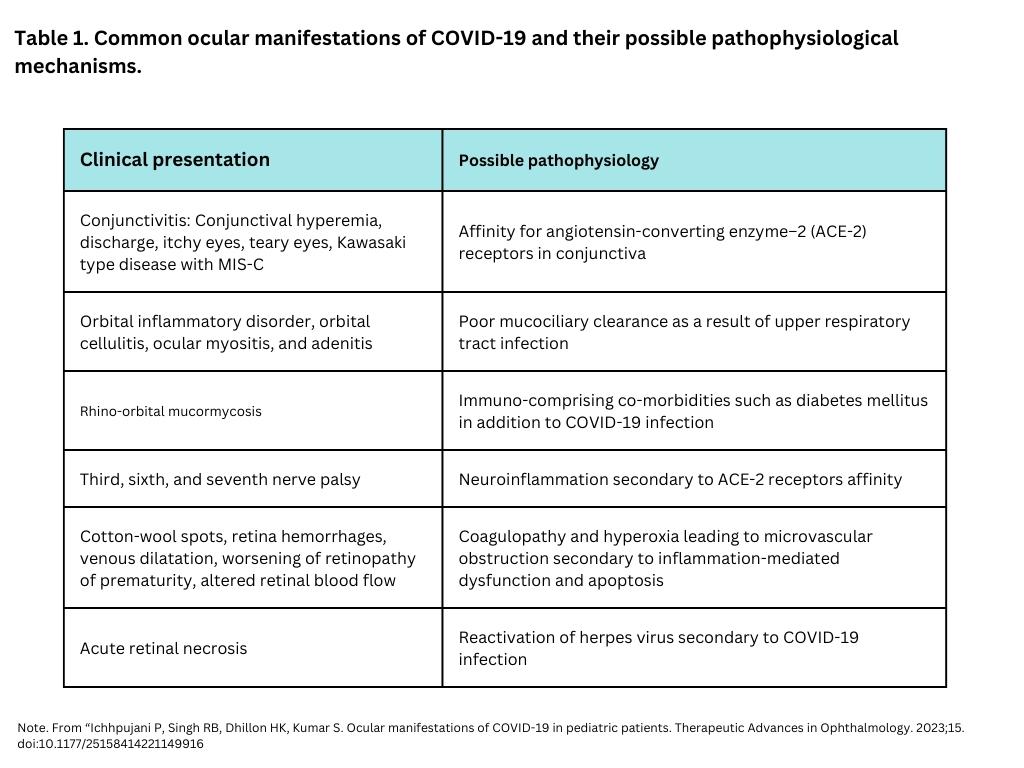- View Ocular manifestations of COVID-19 in pediatric patients Currently reading
In Brief | Ophthalmology | COVID-19
Ocular manifestations of COVID-19 in pediatric patients
Time to read: 01:03
Published on MedED: 22 June 2023
Originally Published: Therapeutic Advances in Ophthalmology
Type of article: In Brief
MedED Catalogue Reference: MOIB002
Keywords: COVID-19, retinal necrosis, orbitary inflammatory disorder, conjunctivities
Published on MedED: 22 June 2023. This summary does not represent the original research, nor is it intended to replace the original research. Content Disclaimer.
In this narrative review, the authors focus on the ophthalmic manifestations of COVID-19 in children. While COVID-19 primarily affects the respiratory system, it can also have systemic effects on various other organ systems, including the gastrointestinal, cardiovascular, neurological, otorhinolaryngologic, and ophthalmic systems. The authors highlight that ophthalmic signs may be the initial and sole indication of COVID-19 infection in children.
To compile their findings, the authors conducted a comprehensive literature search from March 1, 2020, to January 1, 2022, specifically looking for publications related to ophthalmic manifestations of COVID-19 in children.
They identified conjunctivitis as the most common ophthalmic manifestation in children, which can occur at any stage of the disease. Furthermore, the presence of ophthalmic manifestations tends to be more prevalent in children with severe systemic COVID-19. Table 1 represents the more commonly occurring ocular manifestations from the review

Finally, the authors discuss myopia as a long-term consequence of COVID-19. Although not directly related to acute ophthalmic manifestations, the increase in cases of myopia is considered an indirect consequence of the disease.
Based on their findings, the researchers conclude that as the pandemic evolves and until vaccine coverage for children expands, ophthalmologists and paediatricians should maintain a high clinical suspicion for ophthalmic manifestations due to inflammatory changes induced by the virus.
Ichhpujani P, Singh RB, Dhillon HK, Kumar S. Ocular manifestations of COVID-19 in pediatric patients. Therapeutic Advances in Ophthalmology. 2023;15. doi:10.1177/25158414221149916

Back to top
Disclaimer
This article is reproduced under Creative Commons Attribution-NonCommercial 4.0 International License. It is in no way presented as an original work. Every effort has been made to correctly attribute quotes and content. Where possible all information has been independently verified. The Medical Education Network bears no responsibility for any inaccuracies which may occur from the use of third-party sources. If you have any queries regarding this article contact us
Fact-checking Policy
The Medical Education Network makes every effort to review and fact-check the articles used as source material in our summaries and original material. We have strict guidelines in relation to the publications we use as our source data, favouring peer-reviewed research wherever possible. Every effort is made to ensure that the information contained here is an accurate reflection of the original material. Should you find inaccuracies, out of date content or have any additional issues with our articles, please make use of the contact us form to notify us.


